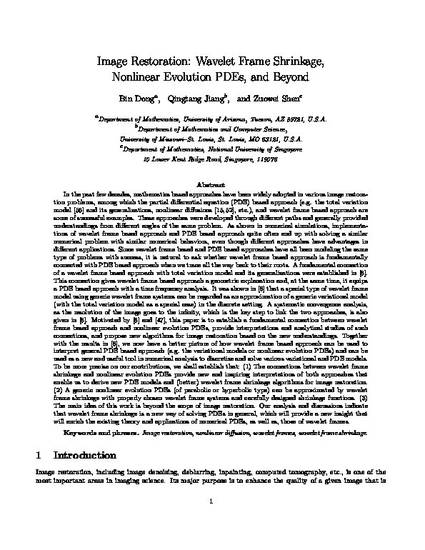
Article
Image Restoration: Wavelet Frame Shrinkage, Nonlinear Evolution PDEs, and Beyond
Multiscale Modeling & Simulation
(2017)
Abstract
In the past few decades, mathematics based approaches have been widely adopted in various image restoration problems, among which the partial differential equation (PDE) based approach (e.g. the total variation
model [56] and its generalizations, nonlinear diffusions [15, 52], etc.), and wavelet frame based approach are
some of successful examples. These approaches were developed through different paths and generally provided
understandings from different angles of the same problem. As shown in numerical simulations, implementations of wavelet frame based approach and PDE based approach quite often end up with solving a similar
numerical problem with similar numerical behaviors, even though different approaches have advantages in
different applications. Since wavelet frame based and PDE based approaches have all been modeling the same
type of problems with success, it is natural to ask whether wavelet frame based approach is fundamentally
connected with PDE based approach when we trace all the way back to their roots. A fundamental connection
of a wavelet frame based approach with total variation model and its generalizations were established in [8].
This connection gives wavelet frame based approach a geometric explanation and, at the same time, it equips
a PDE based approach with a time frequency analysis. It was shown in [8] that a special type of wavelet frame
model using generic wavelet frame systems can be regarded as an approximation of a generic variational model
(with the total variation model as a special case) in the discrete setting. A systematic convergence analysis,
as the resolution of the image goes to the infinity, which is the key step to link the two approaches, is also
given in [8]. Motivated by [8] and [47], this paper is to establish a fundamental connection between wavelet
frame based approach and nonlinear evolution PDEs, provide interpretations and analytical studies of such
connections, and propose new algorithms for image restoration based on the new understandings. Together
with the results in [8], we now have a better picture of how wavelet frame based approach can be used to
interpret general PDE based approach (e.g. the variational models or nonlinear evolution PDEs) and can be
used as a new and useful tool in numerical analysis to discretize and solve various variational and PDE models.
To be more precise on our contributions, we shall establish that: (1) The connections between wavelet frame
shrinkage and nonlinear evolution PDEs provide new and inspiring interpretations of both approaches that
enable us to derive new PDE models and (better) wavelet frame shrinkage algorithms for image restoration.
(2) A generic nonlinear evolution PDEs (of parabolic or hyperbolic type) can be approximated by wavelet
frame shrinkage with properly chosen wavelet frame systems and carefully designed shrinkage functions. (3)
The main idea of this work is beyond the scope of image restoration. Our analysis and discussions indicate
that wavelet frame shrinkage is a new way of solving PDEs in general, which will provide a new insight that
will enrich the existing theory and applications of numerical PDEs, as well as, those of wavelet frames.
Disciplines
Publication Date
January 1, 2017
DOI
10.1137/15M1037457
Publisher Statement
DOI: 10.1137/15m1037457
Citation Information
Bin Dong, Qingtang Jiang and Zuowei Shen. "Image Restoration: Wavelet Frame Shrinkage, Nonlinear Evolution PDEs, and Beyond" Multiscale Modeling & Simulation Vol. 15 Iss. 1 (2017) p. 606 - 660 Available at: http://works.bepress.com/qingtang-jiang/64/
